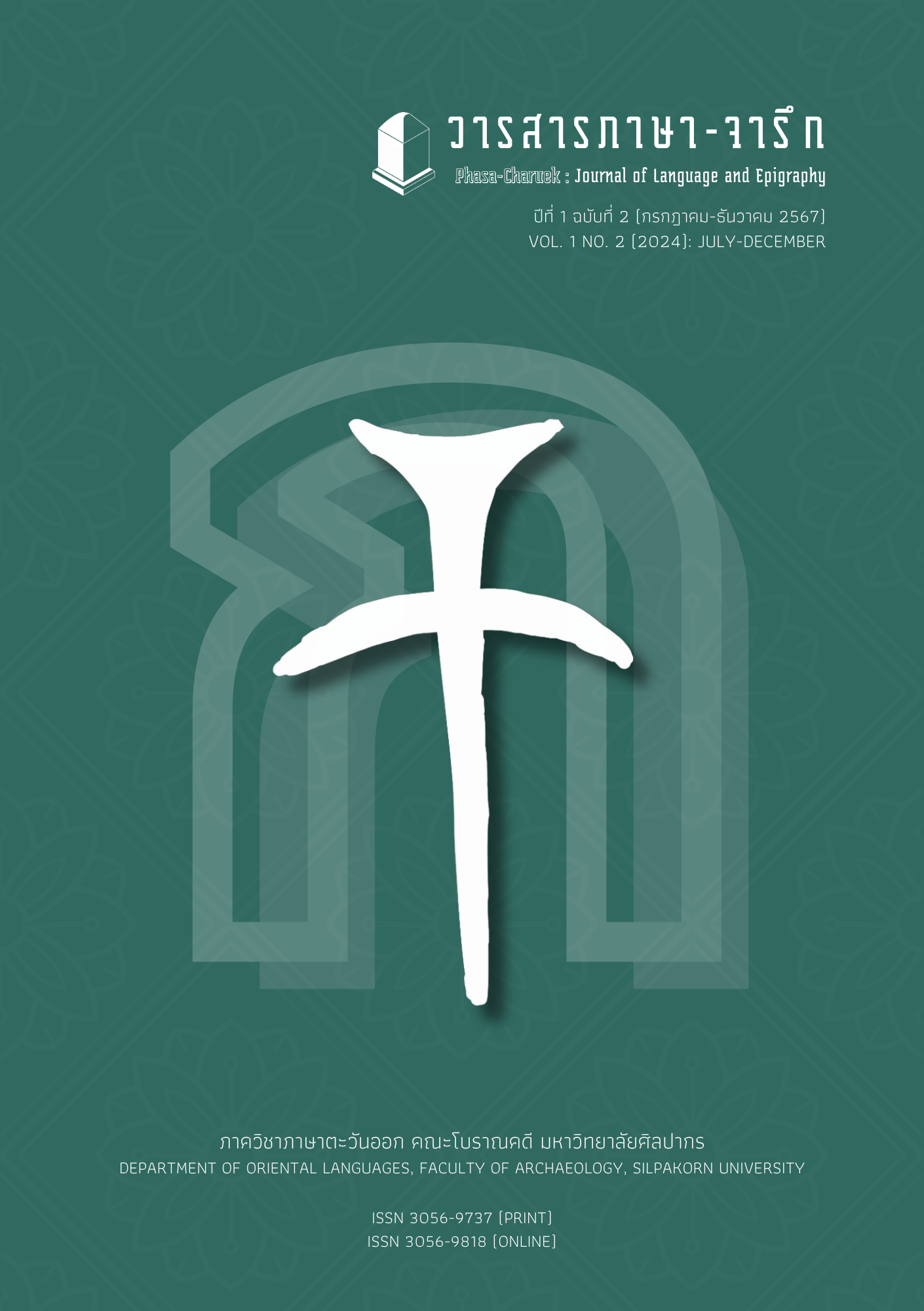Analysis and criticism of the scripts and orthography of the Ban Kum inscription, UBN. 40
Main Article Content
Abstract
The Ban Kum inscription, UBN.40 is an ancient Khmer inscription on the rock wall under the cliff shelter or the first main cave wall of Ubon Ratchathani province. Located in the area of Huai Phai subdistrict, Khong Chiam district same area as Pha Taem National Park. There are prehistoric paintings on the stone walls beneath the longest cliff shelter in Thailand. These rock shelters with inscriptions and paintings are located on a sandstone mountain that extends from the Phu Phan mountain range along the banks of the Mekong River. In the Phu Phan mountain range, inscriptions have previously been found on cave walls, including: Inscription of Tham Phra Temple, SNK. 5, an ancient Khmer script, 1609 B.E. The Ban Kum inscription has numbers indicating the era, which is 811 or 1432 B.E. or the 15th Buddhist century. However, from a comparative study of the scripts and orthography of the Ban Kum inscription with the post-Pallava inscriptions and the ancient Khmer inscriptions that define the era, it was found that the Ban Kum inscription has scripts and orthography consistent with ancient Khmer inscriptions. Mostly the 16th-17th Buddhist centuries, including the inscription Sdok Kok Tham 2, PRI. 4, ancient Khmer script, Sanskrit – Khmer language , 1595 B.E., only on sides 2, 3, and 4, and the Prasat Hin Phanom Wan 3, NMA. 1, ancient Khmer script, Khmer language, 1625 B.E. From the translated words and the scripts and orthography in the Ban Kum inscription, it can be assumed that it is an inscription that records stories from the past or the script used in the Ban Kum inscriptions in 1432 B.E., there was an overlapping script style between the post-Pallava script and the ancient Khmer script and used to have religious places in the area where this inscription was found. It is also popular to make inscriptions on the stone walls under cliff shelters on the Phu Phan mountain range, like making prehistoric paintings at Pha Taem because an inscription was found on a rock wall beneath a cliff shelter on the Phu Phan mountain range in Sakon Nakhon Province, namely the inscription of Tham Phra Temple, SNK. 5, an ancient Khmer script, 17th Buddhist centuries as well.
Article Details

This work is licensed under a Creative Commons Attribution-NonCommercial-NoDerivatives 4.0 International License.
References
จารึกในประเทศไทย เล่ม 1 อักษรปัลลวะ อักษรหลังปัลลวะ พุทธศตวรรษที่ 11-14. (2559). กรุงเทพฯ: หอสมุดแห่งชาติ กรมศิลปากร.
จารึกในประเทศไทย เล่ม 3 อักษรขอมโบราณ พุทธศตวรรษที่ 14-16. (2564). กรุงเทพฯ: หอสมุดแห่งชาติ กรมศิลปากร.
จารึกในประเทศไทย เล่ม 4 อักษรขอม พุทธศตวรรษที่ 17-18. (2529). กรุงเทพฯ: หอสมุดแห่งชาติ กรมศิลปากร.
ชะเอม แก้วคล้าย. (2565). จารึกวิจักษ์ 1. กรุงเทพฯ: สถาบันธรรมชัยวิจัยนานาชาติ (DIRI).
ชะเอม แก้วคล้าย. (2565). จารึกวิจักษ์ 2. กรุงเทพฯ: สถาบันธรรมชัยวิจัยนานาชาติ (DIRI).
สำนักฝรั่งเศสแห่งปลายบุรพทิศ (EFEO). (ม.ป.ป.). Corpus des inscriptions khmères. เข้าถึงเมื่อ 2 มีนาคม 2567. เข้าถึงได้จาก https://www.efeo.fr/espace_prive/paleoCIK.html
Jenner, Philip N. (2009). A Dictionary of Angkorian Khmer. Pacific Linguistics, Research School of Pacific and Asian Studies, The Australian National University.
Jenner, Philip N. (2009). A Dictionary of Pre-Angkorian Khmer. Pacific Linguistics, Research School of Pacific and Asian Studies, The Australian National University.
Inscription 348 N (site: Prasat TA ROS, area: Kompong Thom, Saka year: 876). (ม.ป.ป.) เข้าถึงเมื่อ 2 มีนาคม 2567. เข้าถึงได้จาก https://khmerkhom.wordpress.com/khmer-inscription/pre-angkor-to-876/


